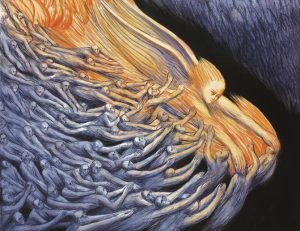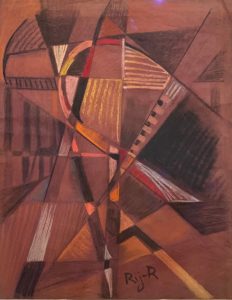Photographs of a woman wearing a bear suit, black-and-white hands, and a maid floating in a swimming pool all collide in the National Portrait Gallery’s exhibition “Portraiture Now: Staging the Self”. This show, which runs until April 12, 2015, displays works by six 21st century Latino artists. Their work represents people in the process of finding their places in the world. The exhibit shows that identity is not concrete; rather, it shifts and changes over time and in different circumstances. Instead of using portraits traditionally to freeze people in a certain pose or moment of life, these artists explore identities dynamically.
María Martínez-Cañas’ Duplicity as Identity caught my attention as I walked through the galleries of portraits. It is a series of nine black-and-white headshots in which Martínes-Cañas fades her frontal portrait onto the image of her father’s head and shoulders in 10% increments. The photographs line three walls of the exhibit room, allowing an observer who stands in the center to pivot and see the gradual transformation from father to daughter. At a glance, the first image, a 10% overlay, looks like a normal portrait of a middle-aged man: the thinning hair, deep-set eyes, pointy nose, and crescent dimple above his chin give him a pensive look. A closer examination reveals the ghostly outline of Martínes-Cañas’ thick hair hovering like a halo around her father’s head. In the 20% overlay, the artist’s irises show faintly in her father’s eyes while the neckline of the artist’s shirt materializes as a light shade of gray.
By the 50% overlay, a clear distinction exists between the original and the half-transformed headshot. In this photograph, the hair of the artist emerges clearly and the eyes grow distinctly wider. The skin of her father’s neck smooths as it morphs into his daughter’s, and her freckles begin to appear. Though the artist’s T-shirt is more opaque, the hair on her father’s chest is still visible. Finally, at the 90% overlay, the artist’s dark, wiry hair eclipses her father’s and creates a strong contrast with the light gray background. Her wide eyes stare straight out, gazing past the viewer. The only remnant of her father’s portrait is a shadow of his white, V-neck shirt and an outline of his left ear. As an observer, pivoting to look at the sequence of overlays is unsettling. The slight changes between each image happen almost too gradually to detect, yet they become abundantly clear when comparing the 10%, 50%, and 90% overlays. The images force viewers to reflect on the gradual changes in their own lives that may lead to identity transformations.
Little shifts add up. Without careful analysis, missing the minute changes that culminate in a strikingly different portrait is easy. “How did it get from there to there?” I heard many visitors wondering aloud, as they pointed from the first portrait to the last. The slow, almost imperceptible changes reflect the ways in which people reinvent themselves at different stages of life. Throughout the years, people switch jobs, meet new friends, and live in different areas. Each of these shifts is like one of the 10% overlay increments: the new experiences cause slight changes in how people think and act, which cumulate in larger identity differences. In Duplicity as Identity, Martínez-Cañas plays with the notion that identity ebbs and flows, which creates illusions and perceptions of reality.
Photo: Maria Martinez-Cañas





